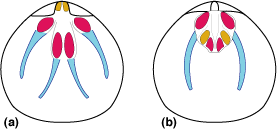 |
|
|
A small extinct order of articulated brachiopods that ranges in age from Early to Middle Cambrian and includes the earliest known calcitic brachiopods. Members of this group were presumably epifaunal and sessile. |
| Order OBOLELLIDA Rowell, 1965 |
|---|
|
Morphology: Obolellids have a biconvex, calcite, impunctuate (lacking holes) shell with an elongated oval shape and a laminar secondary layer. The order includes forms that have primitive articulation of the ventral and dorsal valves—consisting of paired ventral denticles (hinge teeth), where the pedicle (fleshy stalk) attaches to the shell, and dorsal sockets along the internal posterior margin (hinge line)—and forms that lack denticles, such as the genus Obolella. The ventral valve (formerly named pedicle valve) has a well-defined, low and relatively short flat shelf (interarea) at the posterior. The pedicle opening (delthyrium), located between the valves, is either uncovered, as in Obolella, or closed off by convex plates (pseudodeltidium). The mantle canal system lacks bifurcations (baculate type) in both valves (see Fig. a & b). The ventral and dorsal valves contain main mantle canals known as vascula lateralia. The dorsal valve (formerly named brachial valve) also contained a secondary mantle canal, called the vascula media. The muscle arrangement is very similar to that of other articulated brachiopods (see Fig. a & b): in the dorsal valve the pair of anterior and of posterior adductor muscles form a muscle field while the single pair of oblique diductor muscles is attached at the bottom of the pedicle opening (notothyrial cavity). In the ventral valve the pair of diductor muscles are located between the pairs of anterior adductor and of the posterior adductor muscles. |
|
REFERENCES |
|
Superfamily OBOLELLOIDEA Walcott & Schuchert, 1908 |
|---|
|
Family OBOLELLIDAE Walcott & Schuchert, 1908 |
|
Genus Obolella |
|
Family TREMATOBOLIDAE Popov & Holmer, 2000 |
|
Genus Trematobolus |

